
Maintaining HazCom Compliance and Preparing for Future Changes
OSHA is looking to make additional changes to the HazCom Standard to better protect employees.
Staying on top of expanding hazard communication requirements can be overwhelming. There have been numerous changes made to the Hazard Communication Standard (HazCom) since it was first adopted by OSHA for U.S. workplaces nearly 40 years ago. Most notable was the alignment with the United Nations' Globally Harmonized System of Classification and Labeling of Chemicals (GHS), which aimed at creating a standardized global system through which chemical hazards are identified and communicated to all who are potentially exposed.
Now, OSHA is looking to make additional changes to the HazCom Standard to better protect employees in the workplace with updates to align it with GHS Revision 7. While the scope of the changes may not be as wide as OSHA's first alignment with GHS, the impact will be significant, and will require attention and action. The first step is to ensure that your present day HazCom program is compliant with current standards to more easily address the changes to come. Following is a deeper look into the steps you can take to build and prepare that program now.
Build Your HazCom Dream Team
This isn’t typically listed as the first step in a HazCom management plan, which is maybe why so many plans often fail (HazCom violations are number two on OSHA’s list of Top 10 violations in the U.S.). Managing HazCom is a foundational task that requires collaboration with people who know what chemicals are presently at your facility and when new chemicals arrive. It requires a team and some of the key players you need include:
Purchasing Managers. Good communication with your Purchasing Department is really your first line of defense in the HazCom management game. Work with them to establish a clear procurement policy that ensures planned orders for new chemicals go through a comprehensive review and approval process first.
Maintenance Supervisor/Facilities Manager. These individuals have a good sense of what chemicals are used and stored throughout the facility since they’re familiar with all work areas and equipment. They typically know what chemicals are used in maintenance activities, which is essential since these types of chemicals often fly under the radar.
Department Supervisors. This group plays a critical role in HazCom management since they’re dialed-in to plans to bring new chemicals into the facility and know all the ways chemicals are being used and stored. They’re also more likely to know when employees buy chemicals over the counter from industrial supply stores, a situation that often causes chemical products to “sneak in” without formal review or approval.
This article originally appeared in the April 2022 issue of Occupational Health & Safety.